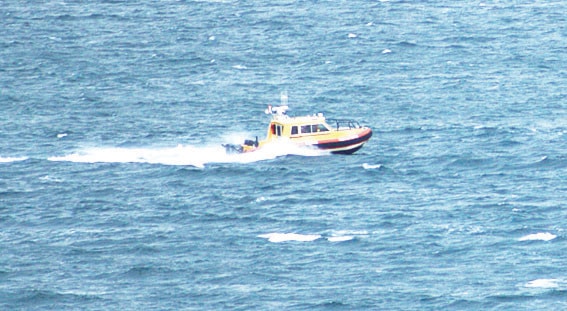Christine Vopel
Sooke News Mirror
Walls of white caps smash and break against the hull of the Spirit of Sooke as she turns to meet the waves head on-- zoning in on GPS co-ordinates tracked through a distress call.
Rob Roe, Station Leader of the Coast Guard Auxiliary, pulls the hood of his red mustang suit closer as he adjusts a dial on the radar-- while scanning the coastline for land marks. Roe, along with his team, are closing in fast but more than 30 minutes have elapsed since they left the dock in Sooke. Cold water and constant thudding of the rescue boat hitting the waves is hard on the team and in a few hours fatigue will take its toll. As for the capsized pleasure boaters, Roe hopes they can find them before it’s too late.
This is a day in the life of the Coast Guard Auxiliary or Juan De Fuca Rescue Society, Station 37 of Sooke. In the past 12 months, the auxiliary, a non-profit volunteer organization, completed 41 missions, were credited with saving 10 lives, assisted 22 others and saved property valued at $625, 300, all at no cost for the calls.
“This has been our busiest year in the last five years,” said Roe. “We do not want people to worry they cannot afford to be rescued. We get a lot of calls when the weather turns bad for the first time and in winter, it can change very fast,” he said.
Station 37 has 23 active members, many who have donated over 1,000 hours of highly trained volunteer time per year. Crews cover shifts 24/7, 365 days a year. In addition to rescues Station 37 promotes boating water safety and awareness, ongoing training in search and rescue, navigation safety, seamanship, communications and first aid.
The Juan de Fuca Rescue Society, covers the largest area of any auxiliary unit spanning from Race Rocks to Nitnat Lake. The organization has become a valuable resource for emergencies involving fishermen, swimmers, shore extraction along the Juan de Fuca marine trail and other sea-bound vessels. They also provide safety for local events and assist with transport of patients and emergency personnel.
The auxiliary strives to respond to Sooke’s growing demand for marine emergency resources by using the most effective vessels and equipment thus ensuring the safety of their crews. But first they need a new vessel.
“We’ve had to turn back a few times. Knowing the limit of your crew and vessel is vital.”
Their current boat; the Spirit of Sooke, was purchased six years ago. It served well but is limited in severe weather.
“The boat is not suitable for the extreme weather conditions we sometimes face and has sustained multiple damages. Twice waves came over the bow and broke the windshield. We were up to our waist in water,” Roe said.
Designed by a navy architect the new Falkens class Search and Rescue vessel features a full cabin, self righting capabilities, a safer propulsion system, improved communications while in transit, increased crew and patient safety and a long range of night vision camera. The life expectancy is 20-30 years.
Roe is excited about the new boat. The vessel is designed to withstand large log strikes at full speed and is already in use by the Nanaimo unit. The Spirit of Sooke will be sold to another unit in a more sheltered location.
The total cost for a new boat will be $525,000. To reduce expenses the auxiliary plans to buy the major components and send them to the boat builder for assembly.
A grant from the district has provided the remaining funding for the new electronics package.
As of now, the organization has funding in place for about 74 per cent of the total project and are planning to fundraise for the rest.
The Juan de Fuca Marine Rescue Society exists due to the generous support it receives from BC Gaming, local and regional governments, service clubs, businesses and the community.
“I think it’s very important to recognize local organizations that support us. It’s really nice when you go for the bill and it’s already taken care of for you by a local business,” said Roe. “The excellent help and support over the past years has had a huge impact on our unit.”
The District of Sooke provides the auxiliary with their training facility, and most recently, moorage.
